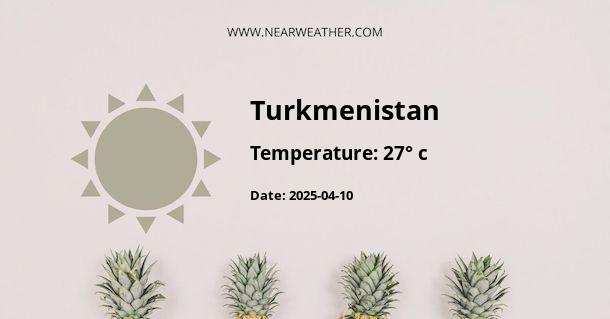Turkmenistan Climate and Weather Year Round
Turkmenistan, officially known as the Republic of Turkmenistan, is a country located in Central Asia. It is bordered by Kazakhstan to the northwest, Uzbekistan to the north and east, Afghanistan to the southeast, Iran to the south, and the Caspian Sea to the west. The climate of Turkmenistan is predominantly arid and desert-like, with extreme temperature variations and limited precipitation.
Climate Zones in Turkmenistan
Turkmenistan can be divided into four main climate zones:
| Climate Zone | Characteristics |
|---|---|
| Desert | Hot summers, mild winters, and very low precipitation |
| Steppe | Hot summers, cold winters, and moderate precipitation |
| Mountain | Cool summers, cold winters, and higher precipitation |
| Caspian Coastal | Moderate summers, mild winters, and higher precipitation |
The majority of Turkmenistan is covered by the Karakum Desert, which has a typical desert climate. The desert experiences scorching hot summers with temperatures often exceeding 40°C (104°F) during the day. Winters are relatively mild, with temperatures averaging around 0°C (32°F) during the day and dropping below freezing at night. The Karakum Desert receives very little rainfall throughout the year, with an average annual precipitation of less than 200 mm.
The steppe climate zone, located in the northern part of Turkmenistan, has hotter summers and colder winters compared to the desert. Summers can be quite hot, with temperatures reaching 35°C (95°F), while winters are cold, with temperatures dropping below freezing. Precipitation in the steppe region is slightly higher than in the desert, averaging between 200-400 mm annually.
The mountainous regions of Turkmenistan, such as the Kopet Dag Range, experience cooler summers and colder winters due to higher elevations. Summers are mild, with temperatures around 20-25°C (68-77°F), while winters can be harsh, with temperatures often below freezing. Precipitation in the mountains is significantly higher than in the desert and steppe regions, ranging from 400-800 mm annually.
The Caspian Coastal region has a more moderate climate compared to other parts of Turkmenistan. Summers are pleasantly warm, with temperatures around 25-30°C (77-86°F), while winters are mild, with temperatures rarely dropping below freezing. Precipitation in this region is the highest in the country, averaging between 400-800 mm annually.
Seasonal Weather Patterns
Turkmenistan experiences distinct seasonal weather patterns throughout the year:
Spring (March to May)
In spring, temperatures start to rise gradually, with pleasant weather in most parts of Turkmenistan. However, strong winds and sandstorms are common, particularly in the desert regions. Precipitation is relatively low during this season.
Summer (June to August)
Summer in Turkmenistan is characterized by extremely high temperatures, especially in the desert areas. Daytime temperatures can soar above 40°C (104°F), and heatwaves are not uncommon. The coastal regions and mountainous areas offer some relief from the scorching heat, with milder temperatures.
Autumn (September to November)
Autumn brings cooler temperatures and more favorable weather conditions. Temperatures gradually decrease, making it a pleasant time to visit Turkmenistan. The country experiences very little rainfall during this season.
Winter (December to February)
Winter in Turkmenistan can be cold, especially in the northern regions and mountains. Snowfall is rare, but temperatures can drop below freezing, particularly at night. The desert regions experience milder winters compared to other parts of the country.
Extreme Weather Events
Turkmenistan is susceptible to extreme weather events, including sandstorms, droughts, and occasional floods. Sandstorms are most common during the spring and summer months, with strong winds blowing fine particles of sand across the desert regions, reducing visibility and causing respiratory problems.
Droughts are a recurring challenge in Turkmenistan due to its arid climate. Limited precipitation combined with high evaporation rates often result in water scarcity and agricultural difficulties. The country has implemented various measures, such as water conservation and irrigation techniques, to mitigate the impact of droughts.
Floods can occur during periods of heavy rainfall, particularly in the mountainous regions and along river basins. These floods can cause damage to infrastructure and disrupt transportation routes.
Conclusion
Turkmenistan experiences an arid climate characterized by extreme temperature variations and limited precipitation. The country can be divided into desert, steppe, mountain, and Caspian coastal climate zones, each with its own unique weather patterns. Understanding the climate and weather conditions in Turkmenistan is essential for planning travel, agriculture, and other activities in the region.
A - Turkmenistan's Latitude is 40.000000 & Longitude is 60.000000.
A - Weather in Turkmenistan is 27° today.
A - Climate Conditions in Turkmenistan shows broken clouds today.
A - Humidity in Turkmenistan is 18% today.
A - Wind speed in Turkmenistan is 22.75 km/h, flowing at 120° wind direction. today.
